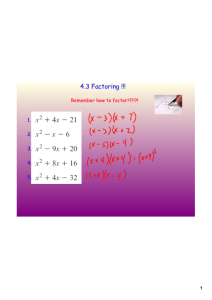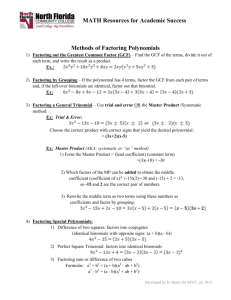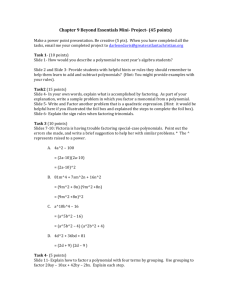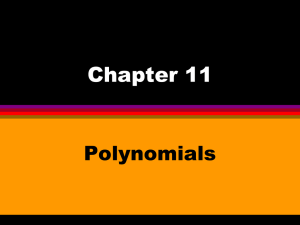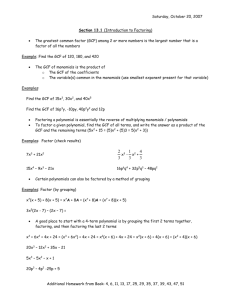Lesson A.3a
advertisement
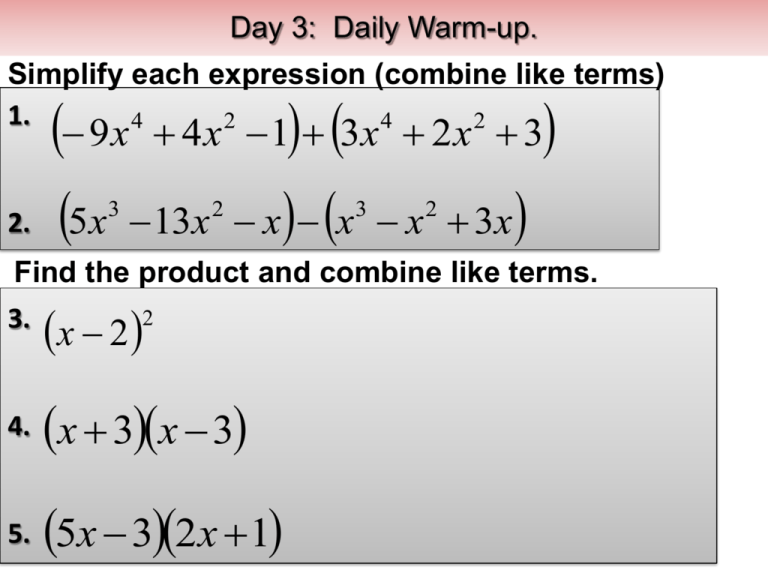
Day 3: Daily Warm-up. Simplify each expression (combine like terms) 1. 4 2 4 2 2. 9x 4x 1 3x 2x 3 5x 13x x x x 3x 3 2 3 2 Find the product and combine like terms. 3. x 2 4. x 3x 3 5. 5x 32x 1 2 A.3a Polynomials and Factoring Special Products and Factoring A.3 Objectives A. Polynomials and Factoring 1. Understand the vocabulary of polynomials 2. Add and subtract polynomials 3. Write polynomials in standard form. 4. Multiply polynomials 5. Special Products 6. GCF 7. Factor Polynomials with 2 or 3 terms. 8. Factor Polynomials with more than 3 terms. 9. Find the GCF of any polynomial expression 1. Vocabulary of Polynomials Monomial: the product of a constant and a variable raised to a nonnegative integer power. ax coefficient of the monomial (constant value) k variable degree of the monomial (power of the variable) Polynomial: sum or difference of monomials 3x 2 4 y 2x 6 5x 2 3y 2 3x 1 1. Vocabulary of Polynomials Special Polynomial Names if # terms is: Name: 2 terms Binomial 3 terms Trinomial Degree of Polynomial if Highest degree term is: degree 1 degree 2 degree 3 Name: Linear Quadratic Cubic Like terms : contain same power of the variable. 2. Add/Subtract Polynomials Add the coefficients of like terms(same power of the variable) Examples 1) 9 x 4 x 1 3x 2 x 3 2) 5x 4 3 2 4 2 13x x x x 3x 2 3 2 3. Standard Form and Degree Definition Standard Form: polynomial written in descending order Example Write the standard form for: Definition 3x x 4 x 7 4 2 The Degree of a polynomial: is the degree of the greatest degree term. Example What is the degree of this polynomial? x 4 2 4. Multiplying Polynomials 1. Double Distribution •Using the distributive property, we can multiply any number of terms 3x 2x 2 4x 1 2. Foil Method •Special case: only works with two binomials x 3x 2 4. Multiplying Polynomials Examples for YOU to try…. Find the product and write in STANDARD form 1) x 1 x x 1 2 2) (3x 1) y (3x 1) y 3) 2 x 1x 21 x 5. Special Products Study Tip These are products that occur often. You should know these! Difference of Two Squares. A B A B A B 2 Perfect Square Binomial. A B A 2 AB B 2 A B A 2 AB B 2 2 2 2 2 2 6. GCF (Greatest Common Factor) Example. Factor out the GCF 4 x 2 x 16 x 3 2 GCF of coefficients: Largest number that divides into all coefficients. GCF of variable expressions: Find smallest exponent Definition of Prime: If a polynomial does not factor into 2 or more polynomials, it is Prime. Day 4: Daily Warm-up. x 1 x 1 2 1. Simplify completely. 2. State the domain of 2 1 2x 4 1 3. Simplify (no negative exponents) 3 xy z 2 6x y z 4. Factor completely. 3x 12 x 36 x 3 2 2 3 2 2 7. Factoring Polynomials Definition: Factoring is writing a polynomial as a product of polynomials of lower degree General Steps for Factoring: 1. Factor out GCFs 2. Is it a binomial (with no middle term) ? a) Is it a Difference of squares or sum/difference of cubes A2 B 2 or A3 B 3 or A3 B3 3. Is it a trinomial (only 3 terms) • apply factorization algorithm 4. If more than 3 terms • grouping 5. More Special Products Difference of Two Cubes. A B A 2 AB B 2 Sum of Two Cubes. A BA 2 AB B 2 A B 3 3 A B 3 3 A. Factoring Binomials Study Tip Factor each. If it does not factor, state that it is PRIME. 1. x 2 25 2. 4 x 25 3. x 125 4 3 4. 8x 1 5. x 1 3 2 2 B. Factoring Trinomials: ax Simple case, when a 1 Example 0. bx c x 4 x 12 2 1. Factor out GCF, if there is one. c 2. What multiplies to c and adds up to b? 3. Rewrite as: (x b )( x ) C. Factoring Algorithm for case when a 1 ax bx c 2 Example 1. 10 x x 3 2 1. Factor out GCF. 2. Multiply a and c ac 10(3) 30 b 1 3. Find the factors of ac that add to b. 4. Rewrite the middle term bx as sum of the 2 factors. 5. Grouping. -Double bubble (check signs) -Factor out GCF in each group, if no GCF, write 1. Factoring Algorithm ax bx c 2 Example 2. 6 x 19 x 7 2 1. Factor out GCF. 2. Multiply a and c 3. Find the factors of ac that add to b. ac 4. Rewrite the middle term bx as sum of the 2 factors. 5. Grouping. -Double bubble (check signs) -Factor out GCF in each group b Factoring Algorithm for simple case, a 1 x bx c 2 Example 3. x 4 x 12 2 1. Factor out GCF. c 2. What multiplies to c and adds up to b? 3. We can skip rewrite of the middle term. (Why?) (x b )( x Factor this polynomial using the “double bubble” algorithm. Do you get the same result? ) Practice Time! completely factor the polynomial 1. x x 2. 8 x 2 32 x 30 3. x 2x 1 4. x5 x 2 7 6 5 3 7. Polynomial with 4 terms Use Grouping (double bubble) Ex. 3x 3 2x 2 12x 8 Factoring Practice completely factor the polynomial 1. 4 x 20x 9x 45 2. 20x 6 12x 5 35x 3 21x 2 3 2 8. Finding the GCF of an expression 1. 6 x(2 x) 9 x 2 x 4 2. 2 3 3x 4 2 x 33x 4 2 5. More Special Products You may wish to memorize these, but could also derive them. Cubes of Binomials, or Perfect Cubes. A B 3 A B 3 A 3 A B 3 AB B 3 2 2 3 A 3 A B 3 AB B 3 2 2 3

